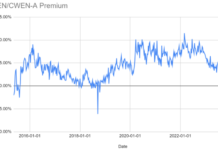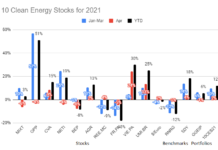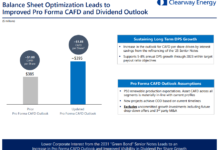Tom Konrad CFA
In the first article of this survey of yield cos, I looked at the possible reasons for the seemingly endless enthusiasm for US-listed clean energy yield cos. Here, I’ll take a look at how these yield cos are constructed, and why investors should prefer one structure over another.
Who’s Your Daddy?
Most yield cos have been created by clean energy project developers in order to create a ready, low-cost buyer for those projects. With the recent string of very successful IPOs, the capital available for such projects may prove to be even lower cost than anyone expected. Terraform Power’s (TERP) on July 18th only makes it more certain that other developers and owners of operating clean energy projects will be rushing new yield cos to market.
A yield co’s parent company is often its largest shareholder, and the relationship may work either to the advantage or disadvantage of other shareholders. On the plus side, many yield cos have a “Right of First Offer” (ROFO) for projects the parent develops. While the details of ROFOs may vary among yield cos, a ROFO will always be a potential source of value for the yield co because it may provide access to a pipeline of projects at favorable prices, or at least the benefits of dealing with a familiar party such as lower due diligence costs for project acquisitions. Since a ROFO is a “right,” not an obligation to buy projects, having a ROFO with an established developer is an advantage for a yield co, and is likely to be a greater advantage if the parent has a large pipeline of projects.
On the other had, many yield cos’ cozy relationships with their parents could easy lead to choices which are not in the best interests of other yield co shareholders. A ROFO may give the yield co the right to buy a project, but this right is of no value unless the project in question is sold at an attractive price. In some cases, the parent may use its effective control of yield co decisions to obtain above-market prices for unwanted projects, doing harm to other yield co shareholders.
Conflicts of Interest
I expect that it will be virtually impossible for most yield cos to escape the influence of their parent companies. In order to mitigate the risk that the parent uses its influence to the detriment of other shareholders, it’s very important that the parent’s interests be completely aligned with those shareholders. For this purpose, I like the parent company to own a large stake in the yield co composed of the same class of shares as common shareholders.
Another red flag is “Incentive Distribution Rights” or IDRs. IDRs allow parent company to receive an increasing percentage of distribution increases. Advocates of IDRs say that they provide the parent with an incentive to increase the distribution as quickly as possible. However, if the parent already owns a large stake in the yield co, the distributions themselves should provide adequate incentive for this purpose.
IDR are also asymmetric incentives: they pay off for the parent when distributions increase, but do not inflict a penalty for a decrease in distributions. Because of their asymmetric nature, IDRs may incentivize increased risk taking, such as using higher levels of debt to increase the dividend. I prefer yield cos without IDRs, or IDRs at low percentages.
Corporate Structures
Most yield cos are organized as corporations, but a few are partnerships. The partnership structure facilitates the use of IDRs, but I consider the corporate form of a partnership to be less important than the existence and level of any IDR.
15 Yield Cos
Six US-Listed Yield Cos
| Name (Ticker) | NRG Yield (NYLD) |
Hannon Armstrong Sustainable Infrastructure (HASI) |
| Annual dividend (Management dividend growth target) | $1.45 (15-18%, five years) | $0.88 (13% to 15% for 2 years) |
| Parent (Ticker) | NRG Energy (NRG) | None |
| Parent’s retained interest | 65.5% voting with complex share structure. | n/a |
| Relationship with parent | ROFO. Parent earns management fee based on assets. | Management has significant stake in common shares; insiders mostly buying in public market. |
| Assets | Solar, Wind, Thermal (facility heating and cooling) | Energy efficiency (performance contracts), Wind, Solar, Geothermal, water, telecommunications and other sustainable infrastructure all of which must contribute to reductions in GHG emissions. |
| Name (Ticker) | Pattern Energy Group (PEGI) |
Terraform Power (TERP) |
| Annual dividend (Management dividend growth target) | $1.29 (10% to 12% for three years) | $0.9028 (15% for 3 years) |
| Parent (Ticker) | Pattern Development (private) | SunEdison (SUNE) |
| Parent’s retained interest | 35% | 71% |
| Relationship with parent | ROFO. Parent will not compete for projects. | ROFO, IDR starting at 0% but increasing to 50%. |
| Assets | Wind | Solar |
| Name (Ticker) | NextEra Energy Partners (NEP) |
Abengoa Yield (ABY) |
| Annual dividend (Management target dividend growth) | $0.75 (12% to 15% over 3 years) | $1.04 ( 6.5%, 12 months) |
| Parent (Ticker) | NextEra (NEE) | Abengoa SA (ABGB) |
| Parent’s retained i nterest |
79.9% | 66.8% |
| Relationship with parent | ROFO, IDR starting at 0% but increasing to 50% | ROFO. Parent provides line of credit. Will have interal management after 1 year. |
| Assets | Wind, Solar | Solar, Wind, Transmission, Conventional generation (gas) |
Four Canadian Yield Cos and One Dual-Listed Yield Co
Most of the Canadian “yield cos” have existed much longer than the term “yield co,” which was coined last year. With the exception of TransAlta Renewables, these were former Canadian Income Trusts, a structure which lost its tax benefits 2011. The ones I have chosen to include here are the ones with the highest proportion of clean energy assets.
| Name (Canadian Ticker, US OTC Ticker) |
TransAlta Renewables (RNW.TO, TRSWF) |
Capstone Infrastructure Corp: (CSE.TO, MCQPF) |
| Annual dividend (My estimate of future growth) | C$0.77 (8% to 15%, 2-3 years) | C$0.30 (0%, 2-3 years) |
| Parent (Ticker) |
TransAlta Corp (TAC) | None |
| Parent’s retained interest |
70.3% | n/a |
| Relationship with parent |
ROFO, managed by parent for management fee based on EBITDA; Parent also supplying line of credit. | Develops projects in-house. |
| Assets |
Wind, Hydro | Combined Heat and Power, Wind, Hydro, Solar, Water utility, district heating |
| Name (Canadian Ticker, US OTC Ticker) | Innergex Renewable Energy (INE.TO, INGXF) | Primary Energy Recycling (PRI.TO, PENGF) |
| Annual dividend (My estimate of future growth) | C$0.60 (2% sustained) | US$0.28 (0%, 2-3 years) |
| Parent (Ticker) |
None | None. |
| Relationship with parent | Develops projects in-house. | Develops projects in-house. |
| Other notes |
The company has stated that it may be for sale. | |
| Assets |
Hydro, Wind, Solar | Waste Heat Recovery, Combined Heat and Power |
| Name (US Ticker, Canadian ticker) |
Brookfield Renewable Energy Partners (BEP, BEP-UN.TO) |
| Annual dividend (Historical dividend growth) | $1.55 (12%) |
| Parent (Ticker) |
Brookfield Asset Management (BAM) |
| Parent’s retained interest |
65% |
| Relationship with parent |
Develops projects in-house. IDR at 15% of future increases eventually rising to 25% |
| Assets |
Hydro, Wind, Combined Heat and Power |
Three UK Listed Yield Cos
These are organized as investment companies, and securities laws make them difficult if not impossible for US based investors to purchase. Because of this, I’m including the UK based yield cos mostly for comparison purpose.
| Name (Ticker) |
The Renewables Infrastructure Group (TRIG.L) |
Greencoat Wind (UKW.L) |
Bluefield Solar Income Fund (BSIF.L) |
| Annual dividend (Target dividend growth) | 6p (with inflation) | 6.16p (with inflation) | 7p (with inflation) |
| Parent (Ticker) |
The RES Group (private) | none | none |
| Assets |
Wind, Solar | Wind | Solar |
Up Next
The final article in this series will discuss which I consider the most attractive investments, and why.
Disclosure: Long HASI, BEP, PEGI, RNW, CSE, INE, PRI, TRIG. Short NYLD Calls.
DISCLAIMER: Past performance is not a guarantee or a reliable indicator of future results. This article contains the current opinions of the author and such opinions are subject to change without notice. This article has been distributed for informational purposes only. Forecasts, estimates, and certain information contained herein should not be considered as investment advice or a recommendation of any particular security, strategy or investment product. Information contained herein has been obtained from sources believed to be reliable, but not guaranteed.









